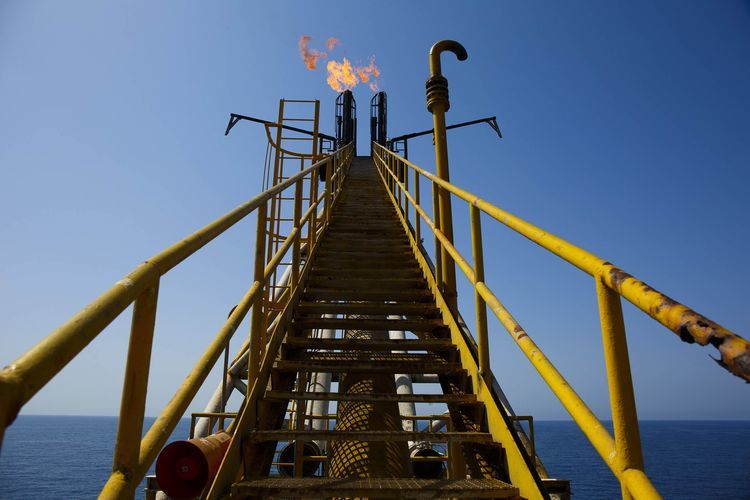
The biggest oil traders feeling the squeeze in a world awash with crude are seeking an edge by offering tailor-made cargoes in an offshore mega store.
By selling bespoke from a fleet of ships anchored off Singapore and Malaysia, the likes of Vitol Group, Trafigura Group, Glencore Plc and Gunvor Group are seeking to lure buyers who are becoming more demanding. With crude from the U.S. to Africa and Europe stored in their tankers, the traders can mix and match oil of differing quality and characteristics to offer made-to-measure cargoes that meet their customers’ niche specifications.
As a glut that’s pummeled crude over the past three years persists and waning price volatility reduces opportunities to profit, traders are contending with increased competition and smaller margins. Now, they are leveraging their global network to source a variety of oils to be shipped to Southeast Asia on very large crude carriers. Then, the cargoes are divvied up, blended if needed, and transferred into smaller tankers to make customized packages.
“These floating vessels allow traders to sell cargoes in smaller parcels which can help when refineries are processing crude for the first time, or when local jetties cannot take in larger vessels,” said Nevyn Nah, a Singapore-based analyst at industry consultant Energy Aspects Ltd. “It also allows sellers to blend different grades to meet specific quality requirements.”
Grades such as Eagle Ford from the U.S., Algeria’s Saharan Blend, North Sea’s Ekofisk and Venezuela’s Diluted Crude Oil have been offered from tankers in the Straits of Malacca, in addition to Australia’s Van Gogh and Oman oil, according to a Bloomberg poll of five refiners and traders involved in the region’s activity. The waters off Singapore and Malaysia are ideal for setting up shop because they’re a gateway to key nations including China, the top energy user, and India, where demand is growing fastest.
At least 15 such vessels are currently floating in the region — all VLCCs with the capacity to carry 2 million barrels of oil each, according to the survey and ship-tracking data compiled by Bloomberg. Companies including Vitol, the world’s biggest independent oil trader, and Trafigura have recently chartered older supertankers for as long as eight months, some of which are likely to be used for storage, Pareto Securities AS said in a note last month.
Press officials at Vitol, Trafigura, Gunvor and Glencore all declined to comment on their strategy.
Contango Trade
The amount of oil stored in tankers reached a 2017 high of 111.9 million barrels last month, according to Paris-based tracking company Kpler SAS. Traders thrived in 2015 and 2016 by taking advantage of the glut that led to a strong “contango” — when contracts for later delivery trade higher than near-term prices. That market structure allowed them to buy oil cheap, store it and benefit later by locking in their profit through derivatives in so-called “cash-and-carry” deals.
Now, there are doubts over whether such trades will be profitable. The premium to be gained from holding supplies of global benchmark Brent for three months has averaged 89 cents a barrel in July. Leasing a VLCC for the same period is estimated by two shipbrokers to cost the equivalent of 85 cents a barrel, before adding other expenses such as insurance and fuel, largely negating potential gains.
Chronic oversupply in global oil and petroleum markets coupled with low price volatility “reduced profitable opportunities for trading,” Trafigura Chief Executive Officer Jeremy Weir said last month, when the third-largest independent oil trader reported a 22 percent drop in first-half profit.
Trial Cargoes
The latest storage strategy means the traders are less beholden to the vagaries of futures prices. At the request of buyers, they can supply as little as 200,000 barrels of oil from tankers for delivery in Asia within a week. That’s attractive for refiners looking to purchase trial cargoes of new grades, crude on smaller vessels, or barrels that are needed in a relatively short time.
Without the floating stores in Asia, getting such smaller shipments from farther away, including the U.S., Europe and Africa, would probably be too expensive for refiners due to high freight costs.
Traders benefit from economies of scale when bringing barrels on large vessels to Asia, and then enjoy additional advantages from blending and customizing sales for refiners, said John Driscoll, the chief strategist at JTD Energy Services Pte, who has spent more than 30 years in the petroleum trading industry in Singapore.
“It caters to smaller and mid-sized refiners who may have capacity or infrastructure constraints and who may be motivated to manage their inventories very closely,” he said. “With the vessels, there is readily available supply without shipping or transit times that can suit a unique requirement.”
Crude Blends
The strategy also allows traders to sell ready-made blends from its ships, such as Vitol’s Malaysian Blend Crude. The grade has qualities of a high-sulfur medium gravity oil that’s favoured by complex plants in Northeast Asia, according to a document detailing its quality specification and traders with knowledge of the variety. It doesn’t share the light and sweet characteristics of supply sold by state-run Petroliam Nasional Bhd and other producers in the Southeast Asian country.
“Traders who’re blending oil on-board large vessels are doing something that smaller independents may have difficulties carrying out, due to infrastructural constraints such as tank configuration and capacity,” said Driscoll. “They’re value-adding by mixing different streams and providing a composite oil that saves the refiner from having to buy cargoes of different grades for blending.”
Recommended for you
